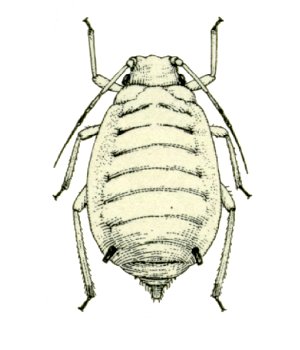
Aphids are small sap-sucking insects and members of the superfamily Aphidoidea. Common names include greenfly and blackfly, although individuals within a species can vary widely in color. The group includes the fluffy white woolly aphids. A typical life cycle involves flightless females giving live birth to female nymphs—who may also be already pregnant, an adaptation scientists call telescoping generations—without the involvement of males. Maturing rapidly, females breed profusely so that the number of these insects multiplies quickly. Winged females may develop later in the season, allowing the insects to colonize new plants. In temperate regions, a phase of sexual reproduction occurs in the autumn, with the insects often overwintering as eggs.

Hoverflies, also called flower flies or syrphids, make up the insect family Syrphidae. As their common name suggests, they are often seen hovering or nectaring at flowers; the adults of many species feed mainly on nectar and pollen, while the larvae (maggots) eat a wide range of foods. In some species, the larvae are saprotrophs, specifically detritivores, eating decaying plant and animal matter in the soil or in ponds and streams. In other species, the larvae are insectivores, preying on aphids, thrips, and other plant-sucking insects.

Brook salamanders are a genus, Eurycea, of salamanders native to North America.
Citrus tristeza virus (CTV) is a viral species of the genus Closterovirus that causes the most economically damaging disease to its namesake plant genus, Citrus. The disease has led to the death of millions of Citrus trees all over the world and has rendered millions of others useless for production. Farmers in Brazil and other South American countries gave it the name "tristeza", meaning sadness in Portuguese and Spanish, referring to the devastation produced by the disease in the 1930s. The virus is transmitted most efficiently by the brown citrus aphid.

Phylloxeridae is a small family of plant-parasitic hemipterans closely related to aphids with only 75 described species. This group comprises two subfamilies and 11 genera with one that is fossil. The genus type is Phylloxera. The Phylloxeridae species are usually called phylloxerans or phylloxerids.
The Small Green Rose Aphid, or Strawberry aphid,, also known as Chaetosiphon (Pentatrichopus) tetrarhodum, is an aphid in the superfamily Aphidoidea in the order Hemiptera. It is a true bug and sucks sap from plants.
The rusty plum aphid is an aphid in the superfamily Aphidoidea in the order Hemiptera. It is a true bug and sucks sap from plants.

The sugarcane aphid,, is an aphid in the superfamily Aphidoidea in the order Hemiptera. It is a true bug and sucks sap from plants. It is mostly found in Saccharum and Sorghum species. The species primarily reproduces via parthenogenesis, although sexual morphs have been discovered in China, Japan, and Mexico - in China the eggs overwinter in the host Miscanthus sacchariflorus.

The ornate aphid or violet aphid is an aphid in the superfamily Aphidoidea in the order Hemiptera. It is a true bug and sucks sap from plants. It is an invasive species.
The Marigold Aphid,, is an aphid in the superfamily Aphidoidea in the order Hemiptera. It is a true bug and sucks sap from plants.

Pentalonia nigronervosa, the banana aphid, is an aphid in the superfamily Aphidoidea in the order Hemiptera. It is a true bug and sucks sap mainly from Musa species.
The Indian grain aphid, also known as Sitobion (Sitobion) miscanthi, is an aphid in the superfamily Aphidoidea in the order Hemiptera. It is a true bug and sucks sap from cereal plants, making it a pest of wheat production. It has also been recorded as a pest of finger millet, sorghum, and pearl millet in South Asia.
Toxoptera odinae, the mango aphid, is a species of aphid in the superfamily Aphidoidea in the order Hemiptera. It is a true bug and feeds by sucking sap from plants.
Tinocallis kahawaluokalani, the crapemyrtle aphid, also known as Sarucallis (Tinocallis) kahawaluokalani, is an aphid in the superfamily Aphidoidea in the order Hemiptera. It is a true bug and sucks sap from plants. It is most invasive aphids known from Crape myrtle. They were first discovered from Hawaii.
The sugarcane woolly aphid is an aphid in the superfamily Aphidoidea in the order Hemiptera. Found in India and Southeast Asia, this true bug sucks sap from plants. It is a foliage sucking aphid species.

Pseudoregma bambucicola, the bamboo woolly aphid, is an aphid in the superfamily Aphidoidea in the order Hemiptera. It is a true bug and sucks sap from plants.
Tetraneura yezoensis, also known as Tetraneura (Tetraneura) yezoensis, is an aphid in the superfamily Aphidoidea in the order Hemiptera. It is a true bug and sucks sap from plants.

Geoica utricularia is a species of aphid. It is a pest of millets.









